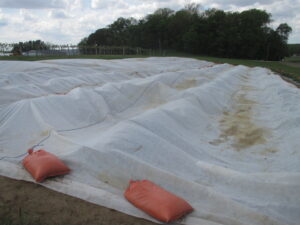Row covers are used in plasticulture strawberry production for winter protection. There is also interest in using row covers to encourage fall growth. The different purposes of using row covers affect when farmers should consider applying the row covers, and what type of materials best meet these goals.
At Strawberry Chat on Plasticulture production, Brad Bergefurd mentioned a major difference between plasticulture and matted row systems is that there may not be a true dormancy in plasticulture strawberry. Directly applying straw on top of plants for winter protection is not a good option in the plasticulture system. It suffocates the plants. Depending on the year, strawberries may stay green until Christmas.
Thick row covers (1.5 oz/yard2 or thicker) are used for winter protection (Figure 1). They are also good for spring frost protection. But thick row covers do not have a good light transmission. Applying these row covers when plants are still green, and still having warm days (average temperatures above 50°F) ahead, sacrifices plant growth days. With this consideration, we have tended to delay applying row covers. In the past few years, we applied row covers close to Christmas in southern Indiana. By then, the plants are typically well-acclimatized and ready for the coldest period.

Figure 1. The strawberry field was covered with floating row covers (1.5 oz) for winter protection.
Fully hardened plants adapted to colder climates can withstand temperatures below –20°F. Plants grown in warmer climates, including cultivars typically grown in plasticulture systems, can not withstand temperatures lower than 10°F. Better protection provided if snow accumulates on the ground on the coldest days. We successfully used row covers for winter protection in one year with the lowest recorded ambient temperatures at –5°F. If lower temperatures are expected and without snow cover, straw may be added on top of the row covers for additional protection.
If cold temperatures come early when plants are actively growing, shall we consider temporarily applying row covers to protect the plants from damage? For non-acclimatized plants, leaves lose photosynthetic activity when they are exposed to temperatures between 20 to 23°F. And crowns may be killed when crown temperatures are at 27°F for 1 or 2 h. As I write this article, the forecasted minimum nighttime temperature was at 28°F in Vincennes, IN. It is not likely the temperatures would cause damage to leaves, and the soil is still warm enough to protect crowns. Considering this, we do not think it is necessary to apply row covers at this time. Actually, the light frost events are helpful to get plants ready for the winter.
In the next article, we will discuss growing degree days and current crop status, and lead to the discussion of whether additional protection is needed to encourage fall growth.
This project is supported by North Central Region Sustainable Agriculture Research and Education program under project number LNC21-454.